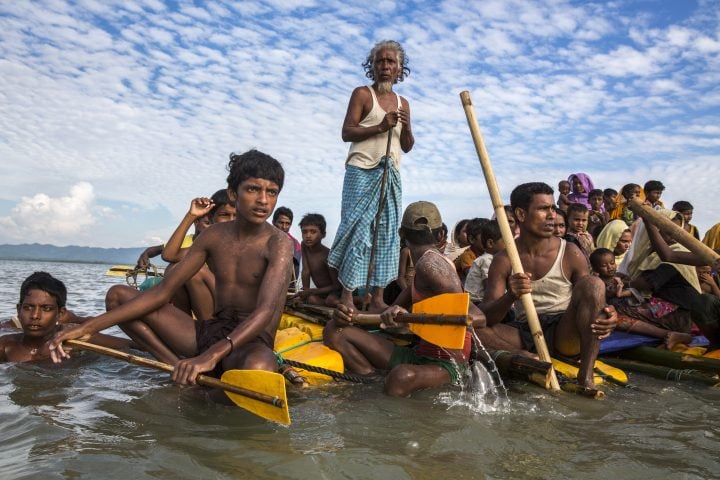By UNHCR Statistics Team, FICSS and Patrick Scott, data journalist.

Rohingya refugees cross the Naf River from Myanmar on makeshift rafts, heading for refugee camps in Teknaf, Bangladesh. ©UNHCR/ Andrew McConnell
UNHCR regularly publishes statistics on forcibly displaced populations to provide information to governments and other organizations that could facilitate long-term solutions for refugees and enhance global advocacy efforts. Reliable statistics provide the foundation for sound policy formulation and lead to more effective measurement, evaluation and accountability for decision makers. Therefore good quality and fit for purpose data is essential.
UNHCR reports data on refugees, asylum-seekers, internally displaced people (IDPs), and stateless people, collecting and collating figures from its own registration database (proGres), national governments, and non-governmental organizations (NGOs).
Notwithstanding the difficulty of reporting high-quality data on refugees, and the political obstacles impacting data collection and the reliability of data sources, UNHCR is taking extra steps to ensure accuracy in its reporting of refugee data. Despite the challenges of estimating this population, UNHCR is confident that the number of people who are forcibly displaced globally is indeed at an all-time high since the end of World War Two.
Measuring refugee numbers
This year’s Global Trends report shows that the world’s refugee population stood at 25.4 million at the end of 2017, 19.9 million of which fall under the mandate of UNHCR. These figures are provided by UNHCR offices, national governments and NGOs with 60% of this population being individually registered by UNHCR.
Measuring refugee populations is not without significant challenges. The quality of the data often depends on the destination and movement of refugees, the size and rapidity of the displacement, and the timing of the integration of refugees in the host community. Ensuring comparable figures in every host country covered by UNHCR is extremely difficult, as definitions and data collection methods differ across countries. Additionally, often governments do not release sex- and age-disaggregated data, or age aggregations are in groups different from those used at UNHCR. Further, refugee data is often considered politically sensitive which can results in challenges in ensuring data release and dissemination.
Measurement is also more complicated than just tracking people who cross national borders. People may enter the refugee population through births or changes in legal status, or they may apply for asylum in more than one country. Refugees returning to their home countries can also be difficult to estimate and rely on reporting from both country of origin and country of asylum. Sometimes these sources are not coherent with one another. For example, when there are spontaneous returns, people may not inform UNHCR and the decrease in the refugee population in the country of asylum will only be reflected following a reverification exercise, usually implemented once every few years.
In an effort to tackle these issues UNHCR is continually seeking to expand its own data recording capabilities. As of March 2018, UNHCR’s individual registration system, proGres, was functioning in 121 countries or territories. In order to address the issue of possible double-counting, UNHCR is also deploying the Biometric Identity Management system (BIMS), which reduces the chance of multiple registrations by creating unique biological profiles of refugees. As well as helping to reduce double counting, this ability to verify refugees also ensures that the right people receive assistance where and when they need it.
UNHCR is making considerable efforts to improve refugee statistics in terms of global consistency and comparability and the latest step taken was the production of the International Recommendations on Refugee Statistics (IRRS), together with some 40 countries and 15 agencies, adopted by the UN Statistical Commission in March 2018. This reference guide for refugee statistics establishes standard statistical concepts of refugees, asylum-seekers and refugee-related populations and a statistical framework which can be readily applied to measure both the stocks and flows of refugees. UNHCR stands ready to support and build capacity in countries to enable them to implement the recommendations.
UNHCR is also leveraging new data sources taking advantage of advancements in technology. In Bangladesh, UNHCR launched a family counting exercise in October 2017, when a team of more than 1000 staff collected information on the refugee arrivals, geo-tagged each family’s shelter, and delivered a card and a unique identification number using an open source data collection and reporting software platform called the KoBoToolbox. Aid workers used their mobile devices to collect information, which was then shared with partners to coordinate aid distribution, assist in site planning, and identify specific needs among the refugee population. The work received a lot of positive feedback.
UNHCR’s response to questions over numbers
The claim that today’s refugee population is the highest on record since World War Two has received some criticisms within the last year. These have centred around the idea that double counting can result in overestimates of the refugee populations and that, relative to global population increases, the increase in displaced populations is not especially significant.
While instances of double counting can never completely be ruled out, especially in cases when asylum seekers apply for asylum in more than one country, the progressive rolling out of the BIMS system is greatly reducing the chance of overestimates occurring, particularly when asylum applications are received by UNHCR.
Additionally, while there may be multiple asylum applications, these cases are often abandoned or administratively closed. This phenomenon was seen especially in 2015 and 2016 when large numbers of asylum-seekers transited through Europe. It would be unusual for a person to receive refugee status in more than one country given the requirements of the refugee status determination procedure.

As for the second criticism mentioned above, since a low of 8.7 million in 2005, the population of refugees under UNHCR’s mandate has more than doubled to 19.9 million in 2017, while the world’s population has only increased by 15% in the same time period. Thus, the share of refugees in the world’s population increased from under 2 per 1,000 to 3.4 per 1,000 over this time. However, the first decade of the 21stcentury saw lower refugee displacement than in the 1990s with refugee numbers peaking in 1992. While absolute numbers in the early 1990s were lower than today, the figure as a proportion of the world population was indeed higher due to the smaller world population. In 1992, there were 20.5 million refugees (17.8 million under UNHCR’s mandate and 2.7 million under UNRWA’s) which accounted for 3.7 refugees per 1,000 world population. Therefore, the world has handled a refugee population of similar proportions in the past. However, the early 1990s refugee crisis was characterized by solutions, especially repatriation, with annual returns in the 1990s often well over one million which is a clear difference with the situation today.
While progress in data coverage, and data disaggregation in particular, can still be made, UNHCR is confident that the data recording practices in place are robust enough to reflect the magnitude of the refugee population and the trends over recent decades. Reliable information that could help policy makers make informed decisions to improve the lives of forcibly displaced populations is a priority for UNHCR. Thus UNHCR works with national partners to build statistical capacity to report on displaced population as well as developing guidance and tools to support and capacitate our own field operations in their statistical reporting.
For more information, please see Global Trends 2017 or contact [email protected]

I have a query – how long is a person counted as a refugee for the purposes of UN statistics. For example if someone is re-settled and becomes a national of the asylum country, are they still counted as part of the refugee population 10 years on?
Once they’re a national of another country they’re no longer consider a refugee (for UNHCR that is, not for UNRWA) and are hence not statistically counted as part of the refugee population anymore.
when was this article published please?
Hi! This article was first published in August 2018.